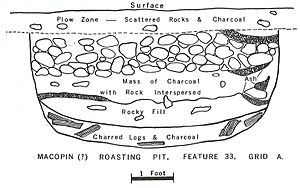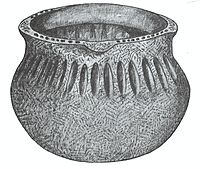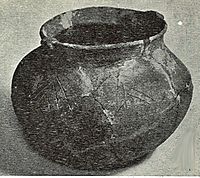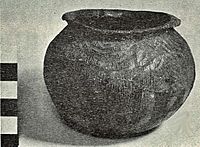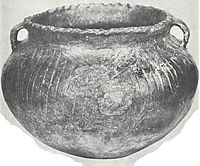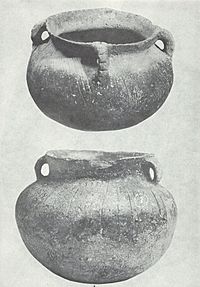Upper Mississippian culture facts for kids
 |
|
| Geographical range | American Midwest |
|---|---|
| Period | Prehistoric, Protohistoric |
| Dates | c. 1000 — c. 1700 AD |
| Major sites | Oak Forest, Carcajou Point, Zimmerman, Anker, Fisher |
| Preceded by | Late Woodland |
| Followed by | New France |
The Upper Mississippian cultures were groups of people who lived in the central United States. They settled near the Mississippi River and the Great Lakes region from about 1000 AD to 1700 AD.
These cultures were similar to, but also different from, the larger "Middle Mississippian" groups. The Middle Mississippians built huge cities, like Cahokia, and relied heavily on agriculture. Cahokia was a massive city, home to an estimated 40,000 people at its peak. In contrast, Upper Mississippian sites were much smaller, usually less than 10 acres.
The Upper Mississippians started around the same time, about 1000 AD. They farmed more than the earlier Late Woodland people. However, they still depended a lot on hunting and gathering. They did not have large, central cities or the same kind of powerful leaders (called chiefdoms) as the Middle Mississippians. Before them, the Late Woodland people lived in small villages and focused on hunting and gathering in the same areas. Sometimes, Late Woodland and Upper Mississippian groups even lived side-by-side.
Most Upper Mississippian groups are part of something called the Oneota aspect. This is like a big family of related cultures. Some well-known groups within Oneota include the Grand River, Lake Winnebago, Koshkonong, Green Bay, Orr, and Utz. The Fisher and Huber groups are also often linked to Oneota. Another group, the Langford tradition, is considered Upper Mississippian because its tools and pottery are very similar to Fisher items. The Fort Ancient Aspect in the Ohio River Valley is sometimes also seen as an Upper Mississippian group.
Contents
What Made Them Special?
One main thing that helps archaeologists identify Upper Mississippian cultures is their pottery. They used crushed shell to strengthen their clay when making pots. This is called "shell-tempering." The Middle Mississippians also did this. Older Late Woodland pottery, however, used grit (like sand or crushed rock) instead of shell. Even though Langford pottery used grit, it's still called Upper Mississippian because it looks so much like Fisher pottery.
Besides pottery, the Upper Mississippians lived a lot like the Late Woodland cultures. They might have farmed more maize (corn), but hunting and gathering wild foods were still very important for their survival.
Tools and Weapons
The Upper Mississippians used small, triangular projectile points called "Madison Points." These were common after 1000 AD and were used for warfare, hunting, and fishing. You often find many of these stone tools at their sites. This might mean there was more conflict during this time.
Other special tools found at Upper Mississippian sites include:
- Double-pointed knives
- Long, thin blades
- Scrapers for preparing hides
- Drills for making holes
- Sandstone tools for straightening arrow shafts
- Hoes made from elk or bison shoulder blades (scapula)
- Tools made from deer bones (metatarsal beamers)
- Round pottery pieces that might have been used for spinning thread
- Game pieces made from antler or bone.
Where Did They Come From?
Archaeologists are still debating how the Upper Mississippian cultures began. One idea is that they were local Late Woodland people who learned new ways from the larger Middle Mississippian groups. Another idea is that they came from those more advanced societies and moved north.
For example, the Aztalan site in Wisconsin shows that Middle Mississippian people moved into that area. But the tools and pottery at Aztalan are very different from Upper Mississippian items. So, it's not clear if one group simply grew out of the other.
Between 1200 and 1500 AD, the climate got cooler. This made farming harder in the Upper Mississippi area. This might be why these cultures relied less on farming and more on hunting and gathering, leading to smaller communities.
Connections with Other Groups
There is strong proof that Upper Mississippians and Middle Mississippians often met and traded. For instance, at the Anker Site near Chicago, Illinois, archaeologists found special items buried with people. These items, like a mask gorget with a "weeping eye" design, are clearly linked to Middle Mississippian sites far to the south. This design is part of the Southeastern Ceremonial Complex. It's not fully known if this means people moved from the south or if it was just through trade.
Their Environment
Most Upper Mississippian sites are in the Prairie Peninsula region of the American Midwest. This area includes parts of Iowa, Missouri, Illinois, northern Indiana, and southwestern Michigan. This was a great place for bison, which were a major food source and provided materials for bone tools. Experts believe bison didn't cross the Mississippi River into Illinois until about 1600 AD.
These sites are usually found in big river valleys, like the Illinois or Mississippi rivers. These locations were perfect because people could easily get resources from different natural areas:
- The prairie (for bison and elk)
- River bottoms (for nuts, berries, and wild turkey)
- Oak savannas (for deer, elk, bear, and more berries)
- The river itself, with its marshes and wetlands (for fish, water lily tubers, mussels, turtles, and waterfowl).
Homes and Buildings
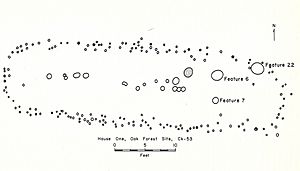
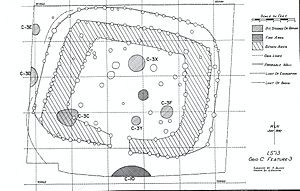
Archaeologists have found different types of houses at Upper Mississippian sites. At the Oak Forest and Anker sites, they found large oval homes, about 25–55 feet long and 10–15 feet wide. At the Fisher and Zimmerman sites, houses were square or rectangular and partly dug into the ground. These were similar to homes found at the Middle Mississippian site of Aztalan.
House styles might have changed over time. It's thought that the square houses at the Zimmerman site were built earlier, when farming was more reliable. These more solid homes suggest a settled farming life. Later, structures at the same site were much simpler, possibly temporary huts. This might be because farming became less reliable, and people moved more to follow bison herds for hunting.
Storage Pits
Most Upper Mississippian sites have many pits dug into the ground. These pits were used for different things:
- Storing food for long periods, maybe through winter.
- Holding trash once the food went bad.
- Roasting food.
- As hearths for fires.
These pits are very important for archaeologists. They often contain broken pottery, stone tools, animal bones, and plant remains. This helps us learn about what people ate and how they lived.
Burial Customs
Some Upper Mississippian sites have both a village area and a cemetery. People were often buried in mounds, like at the Fisher Mound Group. They used different burial styles, including laying bodies out flat or burying bundles of bones.
Sometimes, special items were buried with the dead. The most common items were shell spoons and pottery pots. At the Fisher Mound Group, these pots and spoons sometimes had a greasy feel and tiny bits of bone, suggesting they held food when buried.
At the Anker Site, many burials were found with very rich items. This suggests that some people had higher status or were wealthier than others.
What They Ate
The Upper Mississippians mainly farmed, but hunting, gathering, and fishing were also very important. They focused on getting a lot of food efficiently. This meant growing maize, beans, and squash. They also hunted large animals like deer, elk, and bison, which provided a lot of meat for their communities.
Even though they farmed, they still gathered wild plants. Archaeologists have found remains of nutshells (like hickory nuts, black walnuts, and acorns), wild rice, plums, wild grapes, and other wild seeds.
Some sites show that people focused on certain seasonal foods, like sturgeon fish or water lily tubers. Sturgeon provided a lot of food when they swam upstream to lay eggs. Special roasting pits were used to cook these tubers, which were like potatoes. At some sites, sturgeon bones and water lily tubers were found together in the same pits, showing that people camped there seasonally to get these foods.
Daily Life
It's hard for archaeologists to know everything about daily life because many things, like wood, plants, and textiles, don't last over time. But items made of bone, stone, shell, antler, and copper do survive and give us clues.
Every day, the Upper Mississippian people did many different tasks:
- Hunting and Fishing: They used chipped stone points on arrows with bows. These points could also be used as spear points for fishing. Arrow shafts were straightened using sandstone tools. Bone and antler points and harpoons were also used for hunting and fishing.
- Warfare: Their main weapon was the bow and arrow with triangular points. In later times, they also used gunflints and iron tomahawks, showing more conflict.
- Cutting and Processing: They used many kinds of stone knives for butchering meat, preparing animal hides, cutting fibers or ropes, and processing plants. Sometimes, knives were made from animal shoulder blades.
- Hide-working: Preparing animal hides involved special tools: knives to remove the skin, beamers to remove hair, scrapers for further cleaning, and drills or awls to make holes. Bone needles were used for sewing hides.
- Woodworking: Tools like adzes and axes were used to cut and shape wood. Scrapers and knives helped shape the wood, and drills made holes.
- Sewing: Bone needles were used to make clothing and reed mats.
- Tool Making: Making stone tools was very important. Archaeologists find waste flakes and unused stone cores from this process. Antler tools were used to shape stone.
- Farming and Digging: Hoes made from elk or bison shoulder blades were used for farming and digging. They might have been used to build houses, prepare burials, or dig the many storage, trash, and roasting pits found at sites.
- Cooking and Eating: Daily meal preparation is often seen in the archaeological record through cooking pots, serving tools, and animal bones. Shell spoons were used for serving. Cooking pots often have burnt food residue. Many Upper Mississippian pots had handles, making them easier to move.
Fun, Art, and Beliefs
These parts of life were often connected for the Upper Mississippians.
- Games: Bone and antler cylinders are thought to be game pieces. At the Fisher site, these pieces were found with a stone tablet, forming a "game set." It's possible they were used for gambling.
- Music: Bone rasps (a type of musical instrument) have been found. They might have been used for enjoyment or during ceremonies.
- Smoking Pipes: Smoking pipes were used for both fun and ceremonies. Simple pipes were for everyday smoking, while special pipes, like calumets, were used in ceremonies.
- Personal Adornment: Many items for personal decoration have been found, such as stone, bone, and copper ornaments. These might have been worn daily or as part of special costumes for ceremonies. In later times, Jesuit rings from French missionaries show some people adopted the Catholic faith.
- Art: Works of art were found, often used by medicine men or in ceremonies. These include mask gorgets with artistic designs, engraved pebbles, and animal or bird figurines made of bone, shell, or copper. Copper serpent figurines were common.
- Beliefs: The Native American religious system was often based on animism (belief that spirits are in objects and nature) and polytheism (belief in many deities). Objects were thought to have magical powers. Using them in ceremonies might help please gods or animal spirits. Burying them with the dead might help in the afterlife. Bones of certain animals like heron, bald eagle, crane, otter, or beaver were sometimes buried, possibly as part of "medicine bundles."
- Dog Sacrifice: Dogs were sometimes sacrificed to ask for help from the gods before difficult tasks or in emergencies. Dog meat was also eaten during ceremonies, so finding dog bones at a site often suggests a spiritual meaning. Some sites might have even been special places just for ceremonies or preparing burials.
Tools and Art: What They Left Behind
Here are some examples of what archaeologists have found from the Upper Mississippian cultures:
| Material | Description | Image | Site | Function / Use |
|---|---|---|---|---|
| Chipped stone | Small triangular points (also called Madison points) |  |
Moccasin Bluff site in Berrien County, Michigan | Used for hunting, fishing, or in warfare |
| Chipped stone | Large leaf-shaped blade |  |
Anker site in Cook County, Illinois | For cutting and daily tasks |
| Chipped stone | Uniface humpback end scraper | Griesmer site in Lake County, Indiana | Used for processing wood or animal hides | |
| Chipped stone | Drills (with expanding bases) |  |
Zimmerman site in LaSalle County, Illinois | Used for processing wood or animal hides |
| Stone | Sandstone abrader (also called arrowshaft straightener) |  |
Anker Site in Cook County, Illinois | Used to straighten arrow shafts for bows and arrows |
| Bone | Elk scapula hoes | 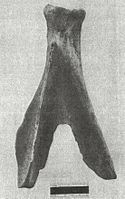 |
Moccasin Bluff site in Berrien County, Michigan | Used for farming, gardening, or general digging |
| Bone | Deer cannon bone beamer |  |
Griesmer site in Lake County, Indiana | A tool for working with animal hides |
| Antler | Antler harpoon | Fifield site in Porter County, Indiana | Used for fishing | |
| Antler | Antler projectile points; socketed and tanged |  |
Griesmer site in Lake County, Indiana | Used for hunting, fishing, or warfare |
| Iron | Tomahawk |  |
Zimmerman site in LaSalle County, Illinois | Used in warfare |
| Bone | Scapula knife or scraper | 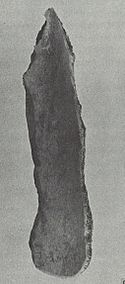 |
Griesmer site in Lake County, Indiana | For cutting and daily tasks |
| Bone | Matting needle |  |
Hotel Plaza site in LaSalle County, Illinois | Used for sewing mats or clothing |
| Shell | Spoons |  |
Zimmerman site in LaSalle County, Illinois | Used for preparing or serving food |
| Bone | Bone cylinders or dice / game pieces |  |
Anker site in Cook County, Illinois | Used for entertainment |
| Bone | Styliform deer bone ornament (possibly a plume holder) |  |
Zimmerman site in LaSalle County, Illinois | For personal decoration or ceremonies |
| Bone | Bone pendants (one shaped like a bird, another broken and shaped like a wheel) |  |
Zimmerman site in LaSalle County, Illinois | For personal decoration or art |
| Bone | Bird bone tubes (possibly for hair or used by medicine men) | 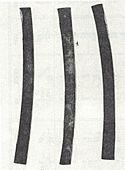 |
Zimmerman site in LaSalle County, Illinois | For personal decoration or ceremonies |
| Brass | Jesuit finger rings | Hotel Plaza site in LaSalle County, Illinois | For personal decoration or religious use (from European contact) | |
| Stone | Elbow pipe fragment |  |
Anker site in Cook County, Illinois | Used for smoking, recreation, or ceremonies |
| Stone | Disc pipe fragment |  |
Anker site in Cook County, Illinois | Used for smoking, recreation, or ceremonies |
| Stone | Rectangular block-shaped pipe fragment |  |
Anker site in Cook County, Illinois | Used for smoking, recreation, or ceremonies |
| Stone | Bear effigy pipe fragment (Whittlesey or Late Woodland style) |  |
Anker site in Cook County, Illinois | Used for smoking, recreation, or ceremonies |
| Stone | Turtle-head effigy pipe fragment (Whittlesey or Late Woodland style) |  |
Griesmer site in Lake County, Indiana | Used for smoking, recreation, or ceremonies |
| Stone | Human head effigy pipe (Iroquoian style) |  |
Anker site in Cook County, Illinois | Used for smoking, recreation, or ceremonies |
| Stone | Celt shaped pipe with incised decoration depicting bison and arrow |  |
Anker site in Cook County, Illinois | Used for smoking, recreation, or ceremonies |
| Bone | Pipe stem made of bone |  |
Anker site in Cook County, Illinois | Used for smoking, recreation, or ceremonies |
| Bone | Rasp (musical instrument) made of bone |  |
Anker site in Cook County, Illinois | Used for music or ceremonies |
| Antler | Bird figurine with socketed pedestal |  |
Anker site in Cook County, Illinois | Art, decoration, or ceremonial use |
| Bone | Wolf mandible pendant |  |
Anker site in Cook County, Illinois | For personal decoration or ceremonies |
| Bone | Snake vertebrae necklace |  |
Anker site in Cook County, Illinois | For personal decoration or ceremonies |
| Copper | Serpent effigy | Anker site in Cook County, Illinois | For personal decoration or ceremonies | |
| Marine shell | Seashell duck effigy pendant |  |
Oak Forest site in Cook County, Illinois | Art, personal decoration, or ceremonial use |
| Potsherd | Sherd pendant | 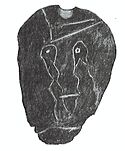 |
Fifield site in Porter County, Indiana | Art or religious use |
| Shell | Mask gorget with "weeping eye" motif |  |
Anker site in Cook County, Illinois | Art or religious use |
Trading with Others
There's a lot of proof that Upper Mississippian cultures traded with each other and with other groups across North America. As mentioned, the "weeping-eye" shell gorget and Middle Mississippian pottery from the Anker site show clear links to sites in Arkansas.
Copper items are often found at Upper Mississippian sites. This copper likely came from the Upper Peninsula of Michigan. It's not clear if the copper was made into tools and jewelry there, or if the Upper Mississippians traded for raw copper and made the items themselves.
They also traded with Iroquoian and Fort Ancient peoples to the east. Archaeologists have found Iroquoian pipes, Whittlesey-style pipes, and Fort Ancient-like pottery at Upper Mississippian sites.
We can often tell about trade between different Upper Mississippian groups by looking at their pottery. Sometimes, a few pots at a site will be of a different style, suggesting they were traded. These "trade vessels" could also mean that people from different tribes married each other. In early historic times, it was common for two or more tribes to share a village, which would also lead to different pottery styles at the same site.
Pottery Styles
Upper Mississippian pottery usually looks like round-bottomed jars with narrow openings and rims that go straight up or flare out. Different pottery styles are identified by things like:
- What material was used for tempering (shell or grit).
- How the surface looks (plain, smooth, or cordmarked with cord impressions).
- The decorations, which are usually on the rim or shoulder of the pot.
Sometimes, other shapes like bowls or shallow pans are found.
Here are some examples of complete or rebuilt Upper Mississippian pots:
Huber Phase
- Sites: Griesmer, Huber, Palos, Hoxie Farm, Oak Forest, Anker, Knoll Spring, Zimmerman (some), Moccasin Bluff, Schwerdt.
- Pottery: Huber Ware. It's shell-tempered, mostly plain, with linear decorations.
- Dates: Around 1425 AD to 1640 AD.
- Changes Over Time: Early Huber pottery often had cord marks and notched lips. Later Huber pottery was rarely cord marked, had fewer notched lips, and used finer decoration lines. Huber pottery is thought to have developed from or replaced Fisher pottery.
- European Trade Goods: Found at Palos, Oak Forest, and Hoxie Farm sites.
- Possible Groups: Likely Chiwere Sioux, Winnebago, or Miami tribes.
Fisher Tradition
- Sites: Fisher Mound Group, Griesmer, Fifield, Moccasin Bluff, Hoxie Farm (some).
- Pottery: Fisher Ware. It's shell-tempered, often cord marked, with curved decorations. Lips are often notched.
- Dates: Around 1520 AD to 1530 AD.
- European Trade Goods: Found at Hoxie Farm.
- Possible Groups: Likely an Algonquian-speaking tribe.
Langford Tradition
- Sites: Fisher Mound Group, Zimmerman, Hotel Plaza, Gentleman Farm.
- Pottery: Langford Ware. It's grit-tempered, with cord marked and smooth surfaces, and curved decorations.
- Dates: Around 1630 AD.
- European Trade Goods: None found.
- Possible Groups: Likely Illinois or Kaskaskia tribes.
Grand River Focus
- Sites: Carcajou Point, Walker-Hooper.
- Pottery: Grand River Ware. It's shell-tempered, smooth, with curved decorations.
- Dates: Around 998 AD to 1528 AD.
- European Trade Goods: Found at Carcajou Point.
- Possible Groups: Likely Winnebago or Chiwere Sioux tribes.
Koshkonong Focus
- Sites: Carcajou Point, Summer Island.
- Pottery: Koshkonong Ware and Carcajou Ware. It's shell-tempered, smooth, with curved decorations.
- Dates: Around 998 AD to 1528 AD.
- European Trade Goods: Found at Carcajou Point.
- Possible Groups: Likely Winnebago or Chiwere Sioux tribes.
Orr Focus
- Sites: Upper Iowa River Oneota site complex, Shrake-Gillies, Midway, Pammel Creek.
- Pottery: Allamakee Trailed.
- Dates: Around 1426 AD to 1660 AD.
- European Trade Goods: Found at Upper Iowa River Oneota site complex.
- Possible Groups: Likely Ioway and Otoe tribes.
Green Bay Focus (Mero Complex)
- Sites: Mero.
- Pottery: A lot of grit-tempered pottery. Handles and decorations are rare. Related to Grand River focus.
- Dates: Estimated 1200 AD to 1400 AD (no radiocarbon dates).
- European Trade Goods: None found.
- Possible Groups: Unknown.


